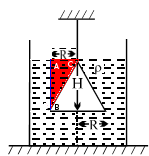 383
383pressure=HÏg
slant surface area=πR√(R2+H2)
force=(Ï€R√(R2+H2))*HÏg
 1133
1133Is it
Ï€R√(H2 + R2) 2[P0 + 23HÏg] ?
 1161
1161Think a bit different way.
 337
337We can calculate the area of the slant height using Ï€R√(R2+H2). Then, find out the area of the triangle ABC. Area= RH/2. Then, we multiply the area with the area of slant height = RH/2 * Ï€R√(R2+H2). Let this value be k. D=M/V. So, M=DV. Density is Ï and volume is k. We multiply them and get mass=Ïk. To find out the force, we multiply it using g. So, final answer=
Ï RH Ï€R√(R2+H2) g2

 1161
1161Well ..what would be the answer if the cone is replaced by a right circular cylinder of same base area and same height. This is a hint for this question.
 337
337Sir,
Is this height the height of the cylinder? If yes, may I know at how much depth this cylinder is kept?
Also, do we have to find out how much force is exerted on the lateral surface of the cylinder or throughout the entire surface of the cylinder?
Thanx...
 1
1Is total force=(2pi*R(∫(pi√(R2+H2)))*rho*g*∫H).....???
 1161
1161The answer will be (piR^2H-1/3 piR^2H)(rho)g
 2305
2305\dpi{150} \fn_cs \textit{Let us consider a small segment of radius r at a depth x below the surface}
\dpi{150} \fn_cs \frac{r}{x} = \frac{R}{H}\Rightarrow r = \frac{x\cdot R}{H}
\dpi{150} \fn_cs dA = 2\pi rdx = \frac{(2\pi Rx )dx}{H}
\dpi{150} \fn_cs \textit{Pressure by the fluid at a depth x = }x\rho g
\dpi{150} \fn_cs dF = P\cdot dA = \frac{2\pi R\rho gx^{2}dx}{H}
\dpi{150} \fn_cs F = \int \frac{2\pi R\rho gx^{2}dx}{H}
\dpi{150} \fn_cs F = \frac{2\pi H^{2}R\rho g}{3}
 158
158B=pVg=TTR2pgH3=pressure on curved part+pressure on base
pressure on base=pgHTTR2
Pressure on curved surface=B-pressure on base=TTR2pgH3-pgHTTR2
 Akash Anand Pressure is not constant throughout the slant surface areaUpvote·0· Reply ·2013-01-21 22:42:41
Akash Anand Pressure is not constant throughout the slant surface areaUpvote·0· Reply ·2013-01-21 22:42:41 Sayan Sinha Here, H is not the height below the fluid. It's the height of the cone.
Sayan Sinha Here, H is not the height below the fluid. It's the height of the cone.

